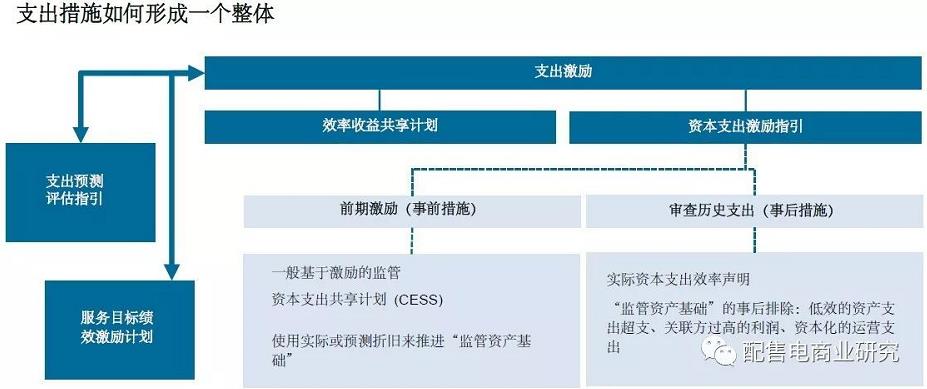澳大利亚能监会电网支出激励性监管指南
发布日期:2018/2/6

在澳大利亚电力市场体系中,市场监管规则是保障市场机制发挥有效作用的重要组成部分。出于其完整性和严谨性需要,监管规则大都篇幅冗长、晦涩难懂。为了帮助更多的市场主体了解市场监管规则,澳大利亚能监会在其网站上通常刊登提纲挈领,阐述要义的总结性短文。我们认为这些短小精干文章可以起到帮助国内读者大致了解澳大利亚电力市场法规的作用。因而我们有意将世界各国电力市场监管机构和市场运营机构发表的这种风格文章收集起来,以中英对照的形式把原文和译文提供给读者,形成系列,希冀对电改有所帮助。我们也希望认同我们想法的专家积极踊跃投稿。
本文资料来自澳大利亚能监会网站。澳大利亚对输电网公司和配电网公司实行经济规制监管,由澳大利亚能监会核准企业的支出测算。为了鼓励电网企业节省成本,提高效率,能监会采用激励性机制与支出测算相结合的方式来促进电网企业更有效地管理支出,并与电力用户分享收益。译者建议本文应与《澳大利亚能监会电网支出测算与审批指南》一起阅读。
什么是基于激励的监管?
Every five years energy network businesses submit to us a proposal forecasting how much they will need to spend over the next five years to provide electricity services, and meet their reliability and service obligations. We approve two key types of expenditure forecasts for the five year regulatory period. Capital expenditure (capex) is the cost of purchasing and installing assets like poles and wires. Operating expenditure (opex) is the cost of running an electricity network and maintaining the assets. Our approach to determining these forecasts is outlined in our expenditure forecast assessment guidelines.
电网企业每五年向澳大利亚能监会(以下简称能监会)提交一份支出测算,用于申报说明未来五年内电网提供供电服务、履行其满足可靠性要求和供送电服务的义务所需要的支出。澳大利亚能监会审批五年监管期的两种主要支出测算——资本支出(capex)和运营支出(opex)。前者是购买和安装资产(比如电线和杆塔)的成本,后者是运行电力网络和维护资产的成本。《澳大利亚能监会电网支出测算与审批指南》概述了能监会审批支出测算的具体方法。
Once the forecasts are set at the start of the regulatory period, the network business has the opportunity to try to provide the required services for less than the forecast and keep the difference. If its spending exceeds the forecast, it must wear the difference itself. At the end of the period the benefits of an underspend (or costs of an overspend) are shared with consumers. We call this ‘incentive-based regulation’. This is done differently for capex and opex.
一旦电网企业的支出测算在监管期开始时得到确定,电网企业就可以尝试以低于测算的支出提供所需的服务,并保留实际支出与预测支出之间的差额。倘若实际支出超过测算的支出,电网企业必须自行承担差额。在监管期终止时,电网企业与消费者分享节省的支出(或分摊超支的成本),这称之为“基于激励的监管”。需要指出的是能监会对资本支出和运营支出采用不同的处理办法。
The two elements to incentive based regulation are how we determine a business’ expenditure forecasts, and the incentives it faces to do better than the forecast. See our expenditure forecast assessment factsheet for more information on how we set forecasts.
基于激励的监管有两个要素,一是如何确定电网企业的支出测算,二是设置激励措施使其做得比测算还好。请参阅《澳大利亚能监会电网支出测算与审批指南》,了解有关如何设定支出测算的更多信息。
运营支出激励有些哪些问题?
Our aim is to forecast the efficient costs of building and maintaining the network. For opex, our approach to forecasting expenditure and the incentive scheme are closely linked. Opex is largely recurrent and predictable. So how much a business spends on opex in one period is often a good indicator of how much it will need to spend on opex in the next period.
能监会的目标是预测建设和维护电网的有效成本。 对于运营支出来说,能监会预测支出的方法和激励机制设计紧密相连。 运营支出在很大程度上是重复发生的、可预测的, 因此,电网企业在一个时期内的运营支出花费,通常能够作为下一个时期运营支出数额的合适指标。
Under our 'revealed cost' forecasting approach we use the actual opex a business spends (with adjustments if it is found to be inefficient) in one year of the regulatory period to forecast its opex needs for the next regulatory period. We refer to this year as the ‘base year’. Under this approach a business would have an incentive to spend more opex in the year that it expects we will use for its next forecast. This would make its future opex allowance larger.
能监会的“显现成本”测算方法('revealed cost' forecasting approach)使用电网企业在监管期一个年度花费的实际运营支出(如果发现效率低下,则进行调整)来预测下一个监管期间的运营支出需求。 实际年度被称为“基准年”。根据这种方法,电网企业将有动机在作为基准年的年度加大运营支出,以期增加其未来每年的运营支出额度。
Our efficiency benefit sharing scheme (EBSS) reduces the incentive that businesses have to inflate opex in the base year. This provides a continuous incentive for businesses to achieve efficiency gains in such a way that they will not benefit from inflating opex in any one year.
能监会的“效率收益共享机制”(EBSS)旨在降低电网企业在基准年度增大运营支出的动机,持续激励企业实现提效增收,这样电网企业任何一年都不能因增大运营支出而受益。
If we consider that past costs are efficient, we will use that as our base for forecasting. If not, we will make an efficiency adjustment to the base expenditure. How we make any such efficiency adjustment is covered in our expenditure forecast assessment guidelines.
如果能监会认为过去的成本是有效的,我们将使用它作为预测的基础。 否则的话,能监会将对基准支出进行效率调整。《澳大利亚能监会电网支出测算与审批指南》描述了能监会是如何进行这样的效率调整的。
“效率收益共享机制”能提供什么激励?
The EBSS works by allowing network businesses to retain underspends for a total of six years, regardless of the year in which they underspend. Consumers then benefit from lower forecast opex in future regulatory periods, which leads to lower prices in the future.
“效率收益共享机制” 的实施方式是允许电网企业保留6年内的节省的支出,不论具体是哪年节省的。之后,电力用户将在接下来监管周期受益于更低的运营支出测算,享受更低的价格。
The combined effect of our revealed cost forecasting approach and the EBSS is that opex efficiency savings or losses are shared approximately 30:70 between the network businesses and consumers. For example, for a one dollar saving in opex the network business gets 30 cents of the benefit while consumers get 70 cents of the benefit.
把 “显现成本”测算方法和“效率收益共享机制”(EBSS)结合起来的执行结果,就是运营支出效益的节省或超支在电网企业和用户之间大约按照3:7的比例分配。例如,对于1元的运营支出节省,电网企业获得30分的利益,而电力用户获得70分的利益。
资本支出激励有些哪些问题?
For capex, the sharing of underspends and overspends happens at the end of each regulatory period. This is when we update the network business’ regulatory asset base (RAB) to include new capex it invested in during the period. A business’ RAB is made up of its capex investments, which it is allowed to earn a return on.
就资本支出而言,对节省和超支的分配发生在每个监管期结束时,能监会将更新电网企业的“监管资产基准”(RAB),并将该监管期间投入的新资本支出纳入其中。电网企业的“监管资产基准”是由其资本支出投资形成的,它是允许收取回报的资产基准。

If a business spent less than its approved forecast, it will benefit during the period. Consumers benefit at the end of the period when the RAB is updated to include less capex compared to if the business had spent the full amount of the capex forecast. This leads to lower prices in the future.
如果电网企业的支出少于其被批准的测算支出,它将在该监管期间内受益,而电力用户在期间结束后受益,因为更新的“监管资产基准”(RAB)将纳入的资本支出要少于电网企业原来测算的资本支出,使得未来价格降低。
As the end of the regulatory period approaches, the time available for the business to retain any savings gets shorter. So the earlier a business incurs an underspend in the regulatory period, the greater its reward will be. As a result, the incentive for a business to spend less than its capex forecast declines throughout the period. So the business may choose to spend capex later, or on capex when it may otherwise have spent on opex, even if it may not be efficient to do so.
随着接近监管期终止时,电网企业保留支出结余的时间变短,从而电网企业在监管期内越早节省支出,其奖励就越大。结果是,对电网企业的实际支出低于其资本支出预测的激励效力在整个监管期间内逐步下降。因此,电网企业可以选择尽量晚花费资本支出,或者把本来可能用于运营支出的资金花费在资本支出上,即使这样做可能不是高效率的。
Also, in the past, we were required to add all capex to a business' RAB regardless of whether it was efficient, or exceeded the approved forecast. This meant consumers were paying prices that reflected all a business’ capex which may have included inefficient capex.
此外,我们在过去曾经将所有资本支出纳入到电网企业的“监管资产基础”(RAB)中,无论它是否有效、是否超过了审批的测算。这意味着消费者支付的价格中反映了电网企业所有资本支出,其中可能包括低效的资本支出。
指南中有哪些资本性支出激励?
The capital expenditure sharing scheme (CESS) provides a network business with the same reward for an efficiency saving and same penalty for an efficiency loss regardless of which year they make the saving or loss in. When the CESS is implemented, a business will retain 30 per cent of an underspend or overspend, while consumers will retain 70 per cent of the underspend or overspend. This means that for a one dollar saving in capex a business gets 30 cents of the benefit while consumers get 70 cents of the benefit.
不论电网企业实现资本支出的结余或超支的年度,“资本支出共享机制”(CESS)都为其提供相同的对节省的奖励或者对超支的惩罚。在实施CESS时,电网企业将保留30%的结余或承担30%的超支,而用电户将获得70%的结余或承担70%的超支。 例如,每节省1元的资本支出,电网企业获得30分的收益,而用电户获得70分的收益。
In addition, if a business’ capex exceeds the forecast, we will examine their spending. If we determine all or some of the overspending was inefficient, the business may not be allowed to add the excess spending to its RAB. This means consumers will not fund that expenditure. This is referred to as an ex-post review.
此外,能监会还进行事后审核。在电网企业的资本支出超过测算时,能监会将审查其实际支出。 如果能够确定所有或部分超支是低效的,能监会则可能不允许电网企业将超额支出纳入到其“监管资产基准”(RAB),意味着消费者不会为这类支出买单。
Our capex incentive measures mean that consumers pay only a portion of efficient overspends, pay nothing for inefficient overspends and consumers share in the benefits when a network business is able to spend less than its forecast capex allowance.
能监会的资本支出激励措施意味着确保消费者只为有效超支部分买单,而无需支付任何无效的超支。在电网企业能够节省资本支出时,消费者仍然能够分享受益。
我们的激励措施作为一个整体是如何发挥作用的?
Our incentive schemes encourage network businesses to make efficient decisions. They give network businesses an incentive to pursue efficiency improvements in opex and capex, and to share them with consumers. Incentives for opex and capex are balanced (30 per cent) and constant. They are also balanced with the incentives under our service target performance incentive scheme (STPIS). This encourages businesses to make efficient decisions on when and what type of expenditure to incur, in order to meet service reliability targets.
能监会的激励机制鼓励电网企业制定经济有效的决策。它激励电网企业不断提高运营支出和资本支出的使用效率,并与消费者分享收益。对运营支出和资本支出的奖励是平衡的(30%)、维持不变的。 它也与能监会的“服务目标绩效激励机制”(STPIS)下的奖励相平衡,鼓励企业为了满足服务可靠性目标,对支出的时间与类别做出经济有效的决策。
The ex post review complements the CESS to provide network businesses with an additional incentive to help ensure that any overspends are efficient and prudent. Under the CESS a business bears 30 per cent of the overspend. However, if the overspend is found to be inefficient, ex post reviews mean the business will bear 100 per cent of the inefficient overspend.
事后审查机制是“资本支出共享机制”(CESS)的补充,为电网企业提供额外的激励,以确保任何超支都是有效和谨慎的。 根据CESS,电网企业承担30%的超支。 然而,如果事后审查发现超支是低效的,电网企业将承担100%的低效超支。
来源: 配售电商业研究 刘东胜、沈贤义译